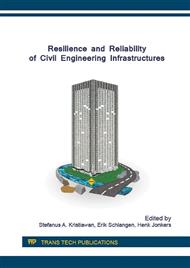[1]
Ministry of Public Works and Public Housing Republic of Indonesia, 2013 Statistical Information Book, The Author, Jakarta, (2013).
Google Scholar
[2]
S.Y. Ok, S.Y. Lee and W. Park, Robust multi-objective maintenance planning of deteriorating bridges against uncertainty in performance model, Advances in Engineering Software 65 (2013) 32-42.
DOI: 10.1016/j.advengsoft.2013.05.009
Google Scholar
[3]
M. Liu and D.M. Frangopol, Multi-objective maintenance planning optimization for deteriorating bridges considering condition, safety and life-cycle cost, J. Struct. Eng. 131 Vol. 5 (2005) 833-842.
DOI: 10.1061/(asce)0733-9445(2005)131:5(833)
Google Scholar
[4]
D.M. Frangopol, K.Y. Lin and A.C. Estes, Life-cycle cost design of deteriorating structures, J. Struct. Eng. 123 Vol. 10 (1997) 1390-1401.
DOI: 10.1061/(asce)0733-9445(1997)123:10(1390)
Google Scholar
[5]
D.M. Frangopol, M.P. Enright, E. Gharaibeh and A.C. Estes, Towards optimal reliability-based bridge maintenance planning: Case studies in optimal design and maintenance planning of civil infrastructures system, ASCE, Reston VA, (1999).
DOI: 10.1061/40492(2000)21
Google Scholar
[6]
M. Liu, A. Hammad and Y. Itoh, Multi-objective optimization of bridge deck rehabilitation using a genetic algorithm, Comput. -Aided Civ. Infrastruct. Eng. 12 (1997) 431-443.
DOI: 10.1111/0885-9507.00075
Google Scholar
[7]
A. Miyamoto, K. Kawamura and H. Nakamura, Bridge management system and maintenance optimization for existing bridges, Comput. -Aided Civ. Infrastruct. Eng. 15 (2000) 45-55.
DOI: 10.1111/0885-9507.00170
Google Scholar
[8]
H. Futura, T. Kameda, Y. Fukuda and D.M. Frangopol, Life-cycle cost analysis for infrastructure system: life-cycle cost vs. service level, ASCE, Reston VA, (2003).
DOI: 10.1061/40707(240)3
Google Scholar
[9]
M. Liu and D.M. Frangopol, Bridge annual maintenance prioritization under uncertainty by multi-objective combinatorial optimization, Comput. -Aided Civ. Infrastruct. Eng. 20 (2005) 343-353.
DOI: 10.1111/j.1467-8667.2005.00401.x
Google Scholar
[10]
S.Y. Lee, S.Y. Ok, W. Park and H.M. Koh, Preference-based maintenance planning for deteriorating bridges under multi-objective optimization framework, Struct. Infrastruct. Eng. 7 Vol. 7-8 (2011) 633-644.
DOI: 10.1080/15732479.2010.501565
Google Scholar
[11]
W.T. Scherer and D.M. Glagola, Markovian models for bridge maintenance management, Journal of Transportation Engineering 120 Vol. 1 (1994) 37-51.
DOI: 10.1061/(asce)0733-947x(1994)120:1(37)
Google Scholar
[12]
G. Morcous, Performance prediction of bridge deck systems using Markov Chains, J. Perform. Constr. Facil. 20 Vol. 2 (2006) 146-155.
DOI: 10.1061/(asce)0887-3828(2006)20:2(146)
Google Scholar
[13]
A. Doyle and B.F. Rabun, Bridges Structures Maintenance Plan, LRFD, Boston, (2013).
Google Scholar
[14]
D. Kececioglu, Reliability Engineering Handbook, Prentice Hall, Colorado, (1991).
Google Scholar
[15]
Y.H. Huang and H.Y. Huang, A model for concurrent maintenance of bridge elements, Automation in Construction, (2011) 74-80.
Google Scholar


